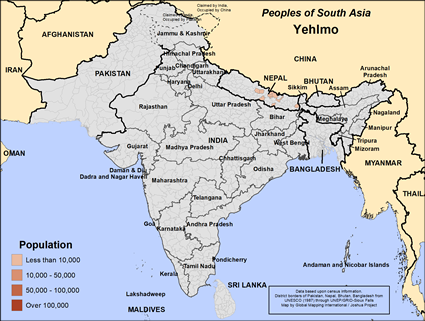Yehlmo in Nepal

Photo Source:
Copyrighted © 2026
Peoples of the Buddhist World, Asia Harvest All rights reserved. Used with permission |

Map Source:
People Group data: Omid. Map geography: UNESCO / GMI. Map Design: Joshua Project
|
| People Name: | Yehlmo |
| Country: | Nepal |
| 10/40 Window: | Yes |
| Population: | 11,000 |
| World Population: | 11,000 |
| Primary Language: | Hyolmo |
| Primary Religion: | Buddhism |
| Christian Adherents: | 0.99 % |
| Evangelicals: | 0.00 % |
| Scripture: | New Testament |
| Ministry Resources: | Yes |
| Jesus Film: | No |
| Audio Recordings: | Yes |
| People Cluster: | South Asia Tribal - other |
| Affinity Bloc: | South Asian Peoples |
| Progress Level: |
|
Introduction / History
The small Yehlmo (or Kagate) tribe is in Nepal. In 1974, the linguists Monika Hoehlig and Maria Hari visited the Yehlmo and estimated their population at about one thousand. They reportedly live 'in the mountains between the Likhu and Khimti rivers in the northeastern part of Ramechap district, wedged in between Solokumbu and Dolakha districts '. Another source says that the Nepal Yehlmo inhabit 'Janakpur Zone, Ramechhap District, on one of the ridges of Likhu Khola '. The Yehlmo in Nepal live at an altitude of approximately 3,000 meters (9,840 ft.) above sea level.
Their language, Hyolmo, is part of the Tibeto-Burman family. It is closely related to Helambu Sherpa, although it differs by using less the honorific system in verbs. People can talk about most common topics in Nepali.
What Are Their Lives Like?
Women are hard workers and have a prominent role in Yehlmo society. They are 'required to collect fuel and fodder, when necessary, and render physical labor in the agricultural process, but are not engaged in plowing or cutting big trees, etc. Women also have a role in animal husbandry and bring potable water from the spring. Women also have roles in ritual and religious spheres. Some of them take active part in politics too. With a major role in family management, they control the family expenditure.
What Are Their Beliefs?
Almost all Yehlmo people are followers of Tibetan Buddhism. Until recently, each family was required to send at least one son to the Buddhist monastery to be trained as a monk. Although this is no longer a binding law, most families continue the practice as they believe it brings honor and good fortune to the family. After a person dies, lamas come to perform complicated cleansing rituals for 49 days. 'They burn 108 chimis (lamps) at a time, every day, during this period ... the lama reads out their religious scriptures. They prepare the cho (different fruits offered to the Buddha) and the torma (a preparation made of rice, wheat and fruits) for votive offering; and after the rituals distribute these among all the relatives, neighbors and friends. The lama gets some money and a khada (scarf) and some food. Generally, a group of six to eight lamas perform all these rituals. '
Most Yehlmo people have never heard the gospel, although a very small Christian community is believed to exist among them in Nepal. Portions of the Bible were translated into their lHyolmo language in 1977.
What Are Their Needs?
The Yehlmo people need to experience and embrace the glory of the Lord. They need to know Christ is far above all others.
Prayer Points
Pray for the glory and the holiness of the Lord to come to every Yehlmo village and family.
Pray for loving ambassadors of Christ to take the gospel to them.
Pray that soon there will be Yehlmo disciples who will make more disciples.